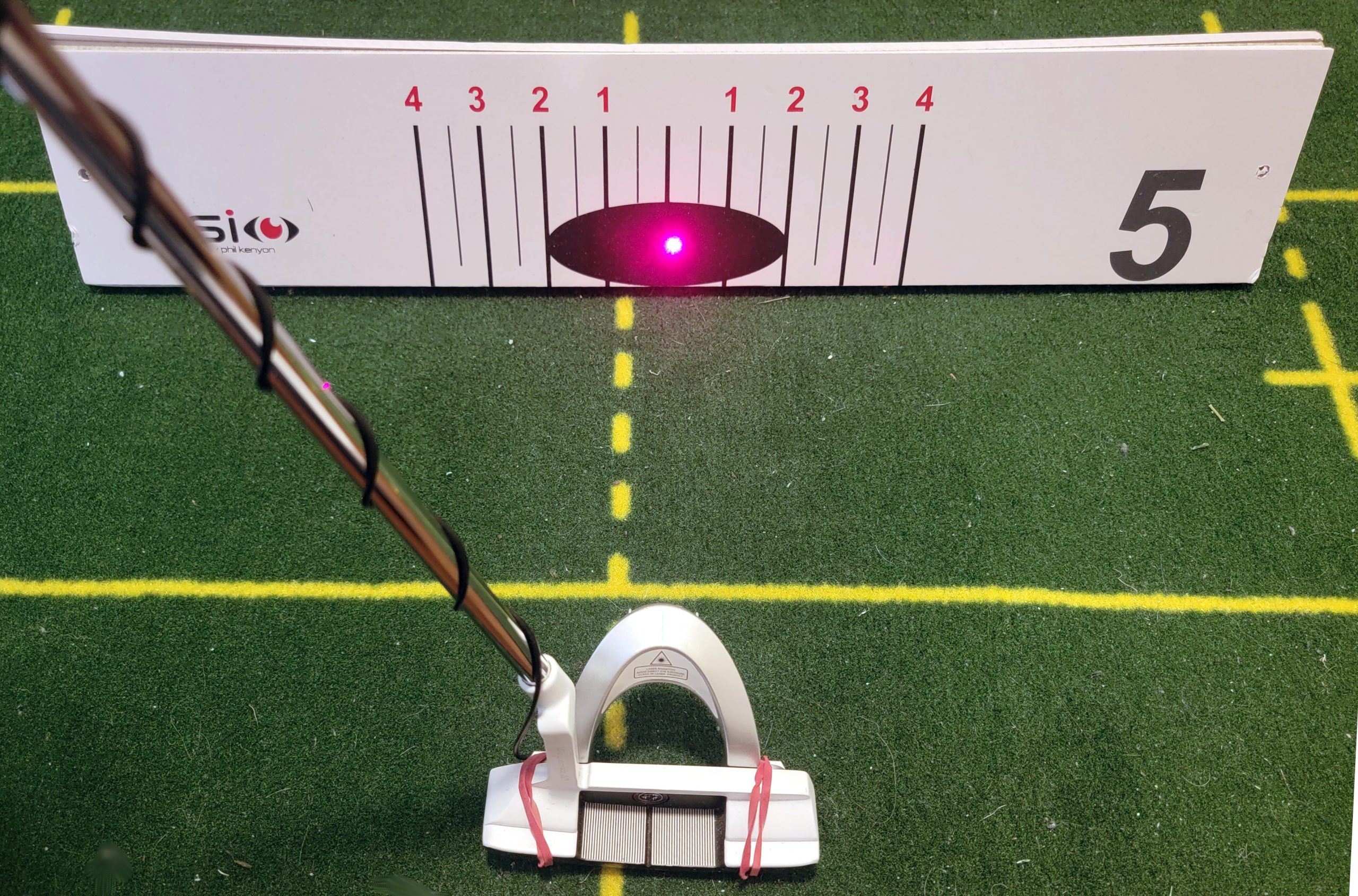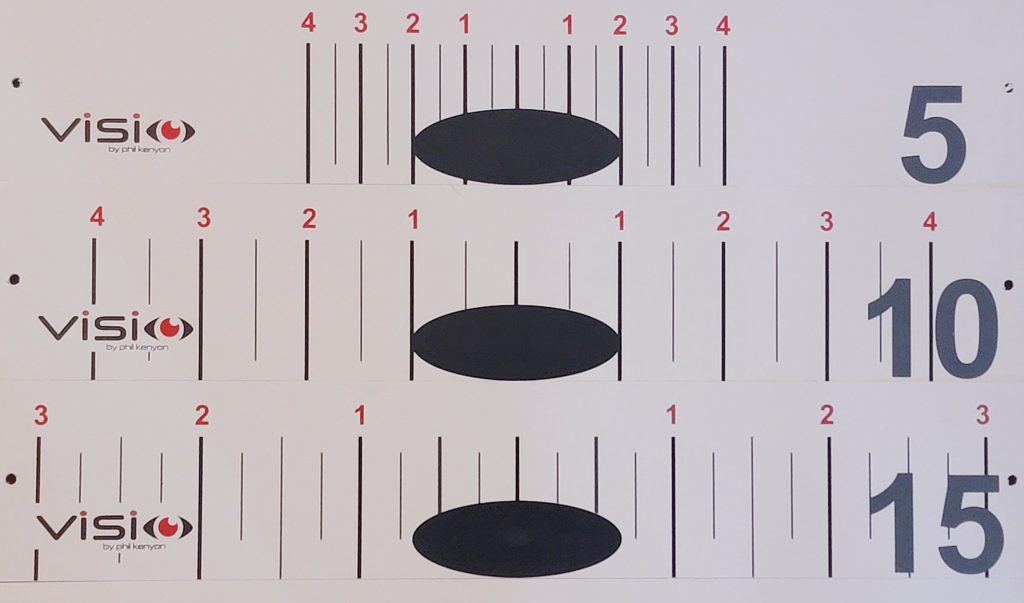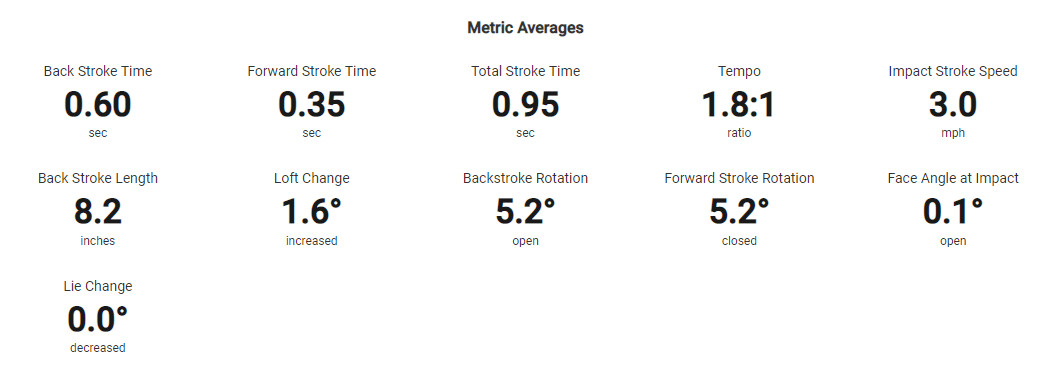Speed, Aim and Line are the 3 putting metrics that have to be in sync. If you want to make more putts, repetition and practice are the key.
If your speed, aim or line is off it affects the other two.
Measuring Metrics
Measuring your putting metrics is the way to go.
Here is an example from Blast Motion Golf of my metrics measured on a pretty good putt.
The image is a one off and isn’t very representative of my averages. It does indicate what you can measure.

10 ft. putt, Stimp reading 11
What can you take away from such metrics?
My average tempo is about 1.8 : 1 so this was right on. My backstroke length average on a ten foot putt is approximately 8 inches to 8.7 inches… so this one is pretty good. Face angle at impact measure 0.0 which is perfect.
Let’s take a look at Speed, Aim and Line separately.
Speed or Pace
How do you control the speed or pace of a putt?
Backstroke length controls distance.
Benchmark your distances based on length of stroke.
I usually start with knowing the stimp reading or speed of the greens.
I ask at the clubhouse, but also know how far my 3, 6 and 10 foot putts “roll” on an 11 stimp green.
The first thing I check when getting to the course is how far my ten footers are rolling.
Stroke through the ball not at the ball.
For me, if I have to “hit” the ball instead of “roll” the ball it’s a problem.
I have a heavier head weight putter for the Spring and Fall when the greens are slower.
In the summer or on fast greens I use a lighter head weight putter which is my gamer.
Where you make contact with the ball on the putter face makes a huge difference.
Just as an example, hitting the ball off the toe can significantly slow the ball down.
Some people would say…”Well my read was off.”
It may be you aren’t striking the ball on the “sweet spot” of the putter face.
Speed control is a result of consistent backstroke and forward stroke symmetry. Consistent tempo is also very important in speed or distance control.
Here is a good video on Speed (Rob Chaney).
Aim
Are you setting up square to your intended target line?
Your putter face should be square to your aim line at setup.

Numbers are degrees of variation from center
I practice this quite a bit with a laser aimer attached to my backup putter. I practice using a Visio aim board. That combination allows me to know if my aim is good at 5, 10 and 15 feet.

Indicates max variance from 5, 10 and 15 ft.
Are you playing the ball in the same place in your stance every time?
Everyone has a perfect place to play to ball so that they are aiming correctly.
If you are one inch forward or back of that spot you will miss by 3 inches left or right for every ten feet.
Mike Shannon, who is an instructor at the PGA Performance Center at the TPC Sawgrass has said that aim is a product of your vision, dominant eye and consistent ball position.
Here is a video on Aim (Mike Shannon).
Line, Aim Line or Path
Are you starting your putts on your intended aim line or returning the putter face back to square at impact?
Professionals strive to be consistently square within a half of a degree at impact.
Why? Take a look at the Visio Aim Board above. You need to be square to one half degree to make longer putts.
I use Blast Motion Golf to measure my ability to return the putter face to square. I practice all winter indoors and chart the results.
Here is a good video on Face Angle at Impact (Blast Motion).
Conclusion
Putting speed, aim and line affect each other. It’s important to become better at all 3.
It can be like a three legged stool with a short leg. One can affect the other two, etc.
I believe you have to measure metrics to get better. Use Blast Motion Golf. That is a sensor that fits on the grip end of your putter and connects to a phone app or tablet app via Bluetooth. It’s not that expensive.
I’m including some of my stats to show that anyone can improve.
I hit thousands of putts trying to get my putting turned around.
I started to get things together after I changed my grip and ball position. I’ve recently changed my stance.
Since I’ve changed to putting with a slightly open stance things have improved. I start out making better putts right away. There has been an noticeable improvement in the average of my Face Angle at Impact and Backstroke Length.
Here are my actual averages for the last 180 ten foot putts I’ve taken.

This represents working on mechanics in the off season. It does not mean the putts went in the hole.
One Concern
***There is one thing I’ve been concerned with. My loft change is always around plus 1.5 degrees.
In other words, I’m adding loft at impact.
This would take a session with SAM PuttLab to figure out I believe.
I know my putter has 3.5 degrees of loft. Add 1.5 to 1.6 degrees of loft at impact and that seems like a lot.
I’ve spoken to a fitter about this. He said that most people do not need 3.5 degrees of loft. Then he suggested it could be just a matter of bending my putter slightly.
I have no idea how much I forward press which decreases loft. Blast Motion Golf doesn’t measure loft at setup.
From filming my ball roll in slow motion high resolution, the ball seems to roll right after impact. This indicates the ball isn’t flying in the air very far before it rolls end over end. So, I’m not real worried.
Practice Options
Speed – Measure backstroke
1.) Alignment rod with markings every inch.
2.) Metal ruler
3.) Putting mat
4.) Golf tees or ball markers every inch
Aim – Setup in relation to target
1.) Putting gates
2.) Putting mat
3.) Golf tee gates
4.) Laser aimer
Start Line – Putter Face at Impact
1.) Putting gates
2.) Triple track ball or line on ball
3.) Golf tee gates
4.) Visio Aim Board
5.) T3 Putting Arc
